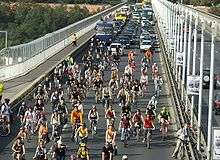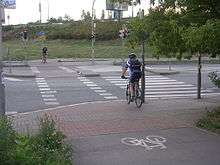Cycling in Prague
Cycling in Prague is a popular leisure activity and not so common mode of transport within the capital city of the Czech Republic. However, levels of utility cyclists are rising every year.[1] In 2018, 2% of people commute by bike in Prague (4% in summer, less than 2% in winter).[2] As of 2017, there were 178 km (111 mi) of protected cycle paths and routes in the city. Also, there were 48 km (30 mi) of bike lanes and 24 km (15 mi) of specially marked bus lanes that are free to be used by cyclists.[3]

History
Prague was never considered as a bike-friendly city. There aren't any signs of cycling infrastructure before WW1. In 1956, the first Copenhagen-style bicycle lanes appeared in Letňany on Letňanská street.[4] Former bike lane is now used as a pedestrian walkway. Cycling infrastructure wasn't really developed during construction of big housing panel house estates as Jižní Město. The first bicycle path in Prague, 1.6 km long, was marked 1986 in Stromovka park.[5] It was built for recreational cycling.
After Velvet Revolution, there was a big pressure on improvement of car infrastructure. Car traffic in the city doubled in first five years after 1989. Popularity of leisure cycling was also increased, the first city cycle routes were marked by a Czech Tourist Club. In 1993, a Council of Prague approved a plan of realization 400 km of cycling routes in Prague until 2000. However, only less than half of the bicycle routes were marked in 2000. First critical mass cycling in Prague was held in 1991 with around 80 participants.[5] In 2007, voluntary association in favor of pedestrians and cyclists, Auto*Mat, was established. There is also a magazine called „Prahou na kole", translated as „Prague by Bike", which includes special online map.[6]

Bike sharing
As of 2019, there are three bike sharing companies operating in Prague. The oldest one is Czech company Rekola, which has 900 pink free flowing bikes around Prague as of 2019, is operating in Prague since 2013. Also, 450 electric bikes called Freebike, owned by Czech company Homeport are operated in Prague since 2019. The third bike sharing system is the only one with physical docks, located along the Vltava river, called Velonet. It has around 50 bikes.
Most of the Prague bikesharing systems function only seasonally.
Bicycle in public transport
Bike transportation is free on Prague Metro, ferries, Petřín hill funicular, in some trams and buses. In metro, bicycles can be transported on the first and last decks of each subway car. Bicycle on trams is allowed only outside of city center, with time exceptions.[7] If person wants to transport a bike in a Prague train, ticket for oversized luggage is needed. Specific spaces for the bikes are marked on from outside of the train. Only two bus lines allow carrying bicycles, as of 2019, those are lines 147 (to Suchdol) and Airport Express.
Gallery
 Cycle lane in the city centre, Zborovská street between Malá Strana and Smíchov
Cycle lane in the city centre, Zborovská street between Malá Strana and Smíchov- Bicycle lane in street V Olšinách
.jpg) Contra-flow cycle lanes and cycle crossing next to Blanka tunnel complex.
Contra-flow cycle lanes and cycle crossing next to Blanka tunnel complex. Soft stones on Rašínovo riverside are used as a bike lane. This riverside is the busiest cycling route in the city centre.
Soft stones on Rašínovo riverside are used as a bike lane. This riverside is the busiest cycling route in the city centre. Separated pedestrian way and bikeway, Podolské riverside under Vyšehrad
Separated pedestrian way and bikeway, Podolské riverside under Vyšehrad Bikeway under Barrandov Bridge, 2017
Bikeway under Barrandov Bridge, 2017
References
- "Prahou vloni jen kolem sčítačů projelo čtyři miliony cyklistů". Čistou stopou Prahou (in Czech). Retrieved 4 May 2019.
- "Potenciál cyklodopravy v Praze". Prahou na kole (in Czech). 4 August 2014. Retrieved 3 December 2018.
- "Yearbook of transport in Prague 2017". TSK-praha.cz. Retrieved 3 December 2018.
- "Letňanská: první pražský cyklopás". Prahou na kole (in Czech). 22 February 2016. Retrieved 22 September 2019.
- "Mapujeme bílá místa pražské cyklistické historie". Prahou na kole (in Czech). 29 May 2017. Retrieved 22 September 2019.
- Rail, Evan. "Getting Around the Czech Capital: How To Navigate Transport in Prague". Culture Trip. Retrieved 28 February 2020.
- "Bicycles and Prague Public Transport". Prahou na kole (in Czech). Retrieved 5 May 2019.
External links
- Cycling map of Prague, website Prahou na kole
| Wikimedia Commons has media related to Cycling in Prague. |